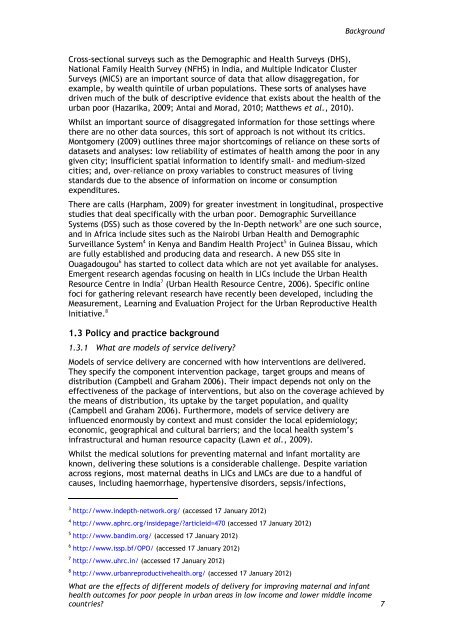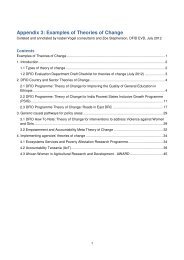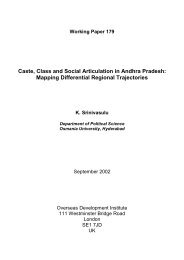Full Report - Research for Development - Department for ...
Full Report - Research for Development - Department for ...
Full Report - Research for Development - Department for ...
You also want an ePaper? Increase the reach of your titles
YUMPU automatically turns print PDFs into web optimized ePapers that Google loves.
Background<br />
Cross-sectional surveys such as the Demographic and Health Surveys (DHS),<br />
National Family Health Survey (NFHS) in India, and Multiple Indicator Cluster<br />
Surveys (MICS) are an important source of data that allow disaggregation, <strong>for</strong><br />
example, by wealth quintile of urban populations. These sorts of analyses have<br />
driven much of the bulk of descriptive evidence that exists about the health of the<br />
urban poor (Hazarika, 2009; Antai and Morad, 2010; Matthews et al., 2010).<br />
Whilst an important source of disaggregated in<strong>for</strong>mation <strong>for</strong> those settings where<br />
there are no other data sources, this sort of approach is not without its critics.<br />
Montgomery (2009) outlines three major shortcomings of reliance on these sorts of<br />
datasets and analyses: low reliability of estimates of health among the poor in any<br />
given city; insufficient spatial in<strong>for</strong>mation to identify small- and medium-sized<br />
cities; and, over-reliance on proxy variables to construct measures of living<br />
standards due to the absence of in<strong>for</strong>mation on income or consumption<br />
expenditures.<br />
There are calls (Harpham, 2009) <strong>for</strong> greater investment in longitudinal, prospective<br />
studies that deal specifically with the urban poor. Demographic Surveillance<br />
Systems (DSS) such as those covered by the In-Depth network 3 are one such source,<br />
and in Africa include sites such as the Nairobi Urban Health and Demographic<br />
Surveillance System 4 in Kenya and Bandim Health Project 5 in Guinea Bissau, which<br />
are fully established and producing data and research. A new DSS site in<br />
Ouagadougou 6 has started to collect data which are not yet available <strong>for</strong> analyses.<br />
Emergent research agendas focusing on health in LICs include the Urban Health<br />
Resource Centre in India 7 (Urban Health Resource Centre, 2006). Specific online<br />
foci <strong>for</strong> gathering relevant research have recently been developed, including the<br />
Measurement, Learning and Evaluation Project <strong>for</strong> the Urban Reproductive Health<br />
Initiative. 8<br />
1.3 Policy and practice background<br />
1.3.1 What are models of service delivery?<br />
Models of service delivery are concerned with how interventions are delivered.<br />
They specify the component intervention package, target groups and means of<br />
distribution (Campbell and Graham 2006). Their impact depends not only on the<br />
effectiveness of the package of interventions, but also on the coverage achieved by<br />
the means of distribution, its uptake by the target population, and quality<br />
(Campbell and Graham 2006). Furthermore, models of service delivery are<br />
influenced enormously by context and must consider the local epidemiology;<br />
economic, geographical and cultural barriers; and the local health system’s<br />
infrastructural and human resource capacity (Lawn et al., 2009).<br />
Whilst the medical solutions <strong>for</strong> preventing maternal and infant mortality are<br />
known, delivering these solutions is a considerable challenge. Despite variation<br />
across regions, most maternal deaths in LICs and LMCs are due to a handful of<br />
causes, including haemorrhage, hypertensive disorders, sepsis/infections,<br />
3 http://www.indepth-network.org/ (accessed 17 January 2012)<br />
4 http://www.aphrc.org/insidepage/?articleid=470 (accessed 17 January 2012)<br />
5 http://www.bandim.org/ (accessed 17 January 2012)<br />
6 http://www.issp.bf/OPO/ (accessed 17 January 2012)<br />
7 http://www.uhrc.in/ (accessed 17 January 2012)<br />
8 http://www.urbanreproductivehealth.org/ (accessed 17 January 2012)<br />
What are the effects of different models of delivery <strong>for</strong> improving maternal and infant<br />
health outcomes <strong>for</strong> poor people in urban areas in low income and lower middle income<br />
countries? 7









